
Atlas in the Royal Palace
|
Dark ominous skies threatened a wet day. Two large factories further down on the other side of the canal continuously belched out gigantic volumes of steam and God knows what else into the atmosphere. They were surprisingly near the city centre.
Rex, who is always up at the crack of dawn, said he watched a large cruise ship slide along the canal to a berth a short distance beyond the Central Station.
After a quick breakfast, we walked at a brisk pace to catch a ferry across to the Central Station, passing the Botel, a large floating hotel boasting double rooms at 85 euros per night. I smiled; we had managed to get a berth for the night for the princely sum of 5.50 euros each. I imagine the folk on the cruise ship would have paid a tad more.
As we approached the ferry terminal, one pulled in, and in no time we were struggling against a torrent of cyclists, all hurriedly pedalling to work. The ferries had a rapid turnaround, and ran precisely to a schedule. Managing to negotiate our way through the hordes, we reached the ferry terminal, and boarded a ferry. Instantly scores of cyclists accompanied us, hurtling onto the ferry at breakneck speed before the ramp went up.
The ferry left promptly, the pilot skilfully avoiding the armada of other ferries, water craft and a large barge.

Great Hall in the Royal Palace
|
We disembarked, and walked through the gleaming Central Station. A busker inside was rattling out a foot tapping boogie-woogie on a grand piano, I was impressed. The tourist information office is conveniently close to the station, and we picked up a map.
Suitably armed, we headed off to the Anne Frank Museum. We had purposely set off early today in order to avoid the inevitable queues; a sensible action to take, hey? The heavens opened and the Gods cried with vigour. We weaved our way down past canals and little side streets, the rain soaking us as it poured down, and drenching us as it bounced back up off the streets. Walking about in the torrents was English madness at its best. Mad dogs and Englishmen walk out in the driving rain as well as the mid-day sun. The Dolhuys in Haarlem had finally got to us. Despite the waterproofs we were wearing, we reached the museum like a trio of drowned rats.
Even though we had arrived at opening time, there was a bit of a queue. Bit is perhaps not the right word, it disappeared around the corner, and wrapped itself around three sides of the large Westerkerk. Gauging by the speed it was moving, we would have been there all day before we even reached the entrance. I had tried to visit the museum in 2011 and 2013, and queues have always been ridiculously long.

Palace Door Panel
|
We retired to a cafe to marshal our thoughts, creating puddles on the floor and exuding wisps of steam from our sodden clothes. We had also planned to visit the Van Gogh museum, but that would have been as bad. "Why not buy the tickets in advance?" you may ask. We did that a couple of years earlier for the Rijksmuseum, and it made no difference at all, we still had to queue for two hours.
Suitably restored, we came up with a plan. We would visit the Koninklijk Paleis Amsterdam (Royal Palace Amsterdam) on the Dam. We arrived there just before the 10am opening time, and there were only a dozen or so people huddled on the steps, trying to shelter from the rain.
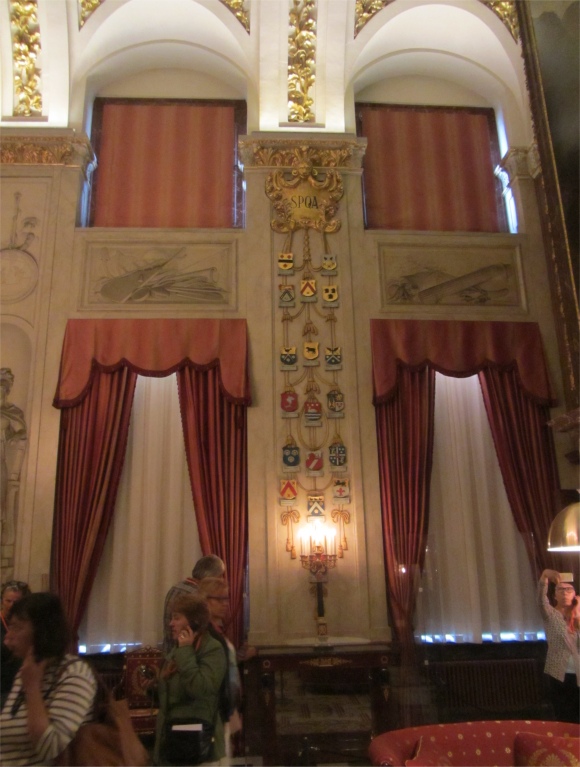
Lavish Interior Room in the Royal Palace
|
The Palace had a varied history, originally built as a town hall for Amsterdam's administrative and judicial authorities. By the 17th century, Amsterdam was the most powerful trading nation in the world. People were attracted by its power and prestige. Newcomers were flocking to the city. As a result, the responsibilities of government were greater than ever before. The old Gothic Town Hall was no longer up to its task and the renowned Exchange Bank, which was housed there, was unable to cope with its growing workload. As a result, the city fathers decided to build a bigger and more impressive town hall, an edifice worthy of a metropolis of Amsterdam's stature. In 1648 the burgermaster and magistrates of Amsterdam commissioned the famous architect Jacob van Campen to design their new building.

A Palace Frieze
|
Van Campen's classicist building, recalling the architecture of ancient Greece and Rome, was monumental by Dutch standards of the day. Both the architecture and the decoration proclaimed by the city's supremacy and prosperity. The Antwerp sculptor Artus Quellinus and other celebrated artists were engaged to execute Van Campen's designs in oil paint and costly stone. The most important rooms were decorated with paintings that related to their function, made by famous artists such as Rembrandt van Rijn, Ferdinand Bol and Govaert Flinck. In the imposing Citizens' Hall, the eastern and western hemispheres were laid into the floor in marble. Though far from ready, the town hall opened its doors for business in 1655. The delighted citizens of Amsterdam proudly referred to it as "the eighth wonder of the world", and the poet Joost Vondel proclaimed it the "crown of creation".
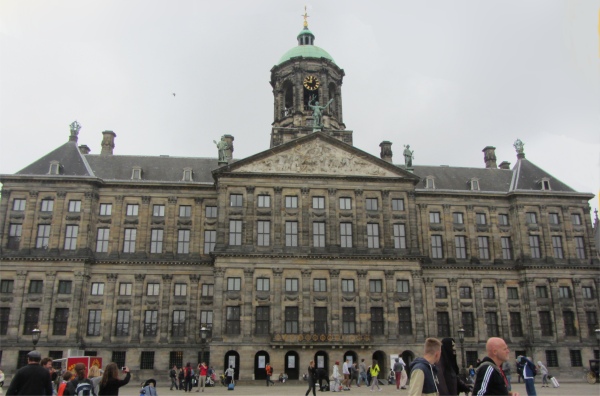
The Royal Palace
|
In 1806, Napoleon's brother, Louis Napoleon, had become the king of Holland. In 1808 he decided to make the Town Hall his residence. The entire administration was moved out of the building. A door was introduced in the south facade to provide direct access to the Exchange Bank, the only municipal institution that remained in the building. A palace with an Exchange Bank on its premises was certainly something out of the ordinary.
The lavish interior and furnishings gave us some idea of how the building was transformed into a palace in the French Empire style. The cells became wine cellars and the cold marble floors were covered with thick carpets. In the middle of the fašade, at the height of the first floor, Louis Napoleon had a balcony fitting. At the "Krijgsraadzaal" and adjoining rooms on the third floor, he established a "Royal Museum".
The biggest change was a special addition: Louis Napoleon had his new Palace furnished in the latest fashion, the French Empire Style. That style was inspired by antiquity, just like the architecture of the Town Hall. The superb collections of Empire furniture, clocks and chandeliers are one of the best preserved and most complete Empire collections in the world. Napoleon Bonaparte's patience soon wore thin. In 1810 Louis was forced to leave the country. After Paris and Rome, Amsterdam had been the third capital of the Napoleonic Empire. And for a fleeting moment in its history the Town Hall had served as the third Imperial Palace in the declining years of the Empire. Almost the entire collection of costly furniture dating from that time was left behind.

The Dam with the Royal Palace, De Nieuwe Kerk and the National Monument
|
When the French Empire came to an end, Frederick of Orange-Nassau, the son of the last "Stadhouder", came back to the Netherlands. In December 1813 he went to Amsterdam and declared that he would return the former Town Hall to the city. During his visit he stayed in the Palace. The proclamation, in which he accepted the sovereignty of the Netherlands as William I, was signed here. The "Prinsenhof" was the place where the city council was established. So the Palace remained a Palace. William I saw the importance of staying in the capital. The city council of Amsterdam proclaimed that the building would be available again to the Sovereign. Initially, William I made a lot of use of the Palace. In 1814 he received his first state visit, the Russian Tsar Alexander I. But quickly his interest in the building waned. Even King William II and King William III spent just a few days per year in the building.
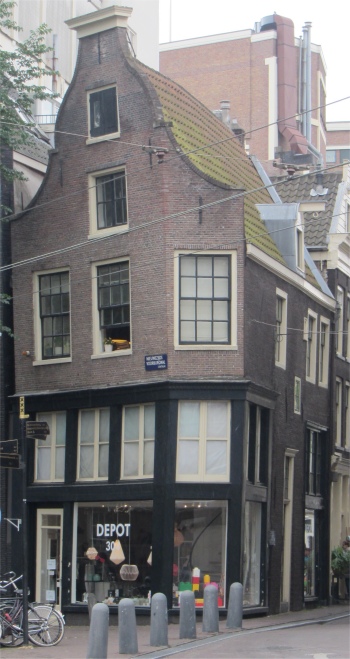
Leaning Building on Nieuwezijds Voorburgwal
|
The building was ideal for official receptions and other royal occasions, but the fact that was unoccupied for long periods led to mounting criticism. Political and economic circumstances directed the course of the continuing debate. In the 1930s, legal experts were asked to determine who actually owned the building. The answer was that it belonged to the city. A comprehensive plan to restore the building for service as a town hall was drawn up in 1934. In the prevailing economic climate, however, the project was unfeasible. In 1935, Amsterdam's municipal executive passed a momentous resolution: the city sold the building to the State of the Netherlands for ten million guilders. The State offered the Royal House permanent use of the building. The Palace was inaugurated by Queen Wilhelmina. In 1938 she celebrated her fortieth jubilee in the Palace. In the last years of her reign Queen Wilhelmina used the Palace as her "Winter Palace". From the Palace she made small excursions into the city and sitting on the roof she painted the sky.
Nowadays the Royal Palace Amsterdam is one of three Palaces used by the Dutch Monarch, notably for State Visits, Award Ceremonies, New Year's Receptions and other official functions. The building plays a role in royal marriages and in the abdication and investiture of the Monarch. When the Palace is not in use by the Royal House, the Amsterdam Royal Palace Foundation opens the building to the public.
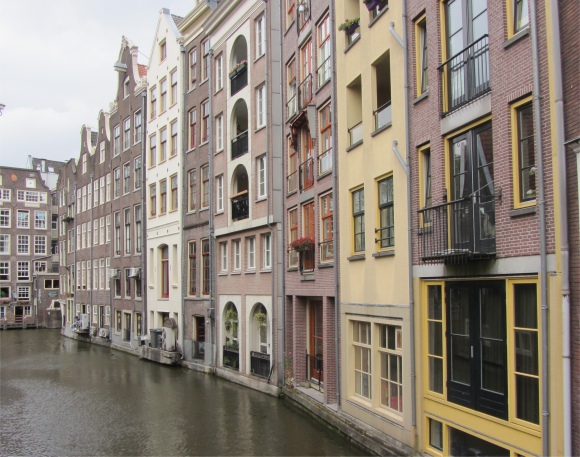
De Gouden Bocht Perhaps?
|
A truly excellent feature of the visit was the audio device we were each provided with to self-guide ourselves around the palace. Within the many rooms and corridors of the building, 2m high display boards stood, each providing a brief account of the room or objects we were looking at. The icing on the cake was the fact that by pointing our audio devices at these stands, the devices were enabled to provide more detailed audio accounts of what was being displayed. It worked very well. We started our tour in the great hall, on the floor of which lay three enormous marble floor maps, one of each hemisphere and one of the stars and constellations in the heavens. A large monument of Atlas presided over us all. The lavish interior was decorated with multiple statues and friezes, marble carvings of scenes from Greek tales and the Bible. In the public rooms and sumptuous furnished more private ones leading off from the hall, snapshots of the history of Amsterdam were captured: rooms for insurance of cargo, for banking, for transport, for taking care of the poor of the city, and the city government itself. Indeed the whole palace could be considered a beautiful work of art. I would certainly recommend a trip to the Palace.
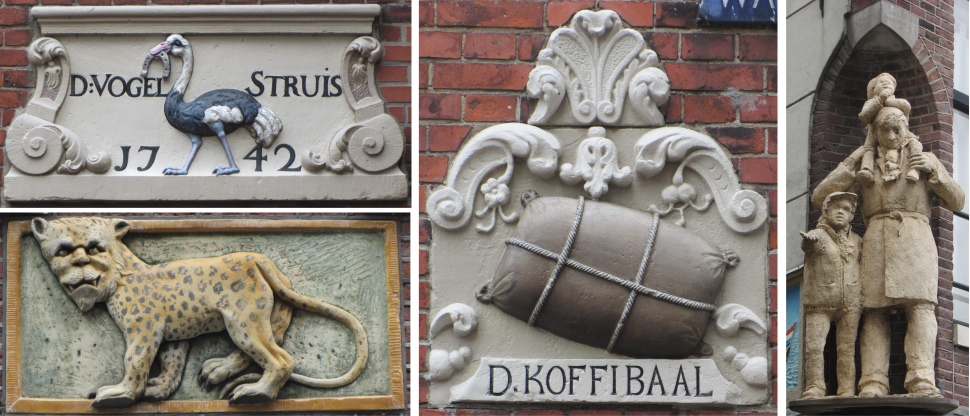
Selection of Wall Decorations
|
We left the magnificent building and walked out onto the Dam. The square was created in the 13th century when a dam was built around the river Amstel to prevent the Zuiderzee from inundating the city. The dam, a wide bridge with wooden doors to stem the flow of water during high tide, was located roughly between the National Monument and the busy Damrak/Rokin thoroughfare. However, deep beneath the cobblestones there is a culvert through which water from the river Amstel still flows from Rokin to the remaining cul-de-sac of water at Damrak near Central Station. As well as the Royal Palace, the square contained the controversially phallic National Monument statue, erected in memory of Dutch soldiers and members of the resistance who died in World War II. Unveiled in 1956, the monument stores soil from all of Holland's provinces as well as from the Dutch East Indies, and also the crests of the provinces.
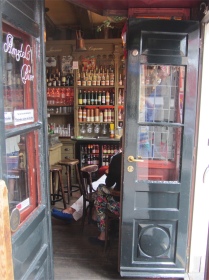
Well Stocked Bar
|
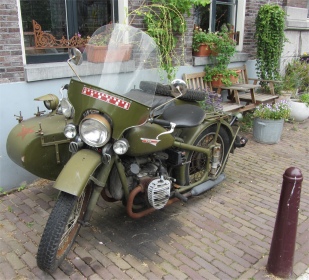
The Dutch Love Their Bikes
|
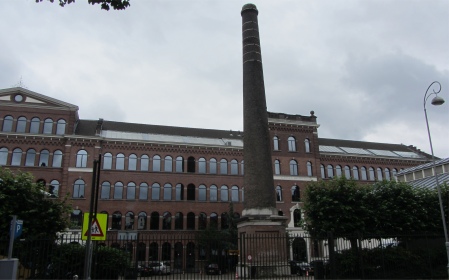
Revamped Flats
|
As well as all manner of characters representing humanity, an escapologist performed his trade in the square. His commentary was highly amusing, I am not sure if all of the non-English speaking people understood his many innuendos, but he created much mirth, and of course the eventual drawn out outcome was predictable.
Not far away from the Dam was the Amsterdam Museum. This excellent museum gave an account of the city's thousand-year story based on the core values: burghers caring for the less fortunate, ships sailing to Asia and America, freedom of conscience, art, oppression, slavery and war.
The history started off by showing how Amsterdam was built on millions of wooden piles driven deep into the marshy peat. Of course today concrete piles are used. Midway through the 16th century, Amsterdam became part of the powerful Habsburg Empire, whose rule extended to Asia and America. In the 17th century, Amsterdam's merchants began to dominate world trade with their fast ships, from Scandinavia to Japan, the East Indies and America. The Dutch East India Company (Verenigde Oost-Indische Compagnie, VOC) became the world's first multinational. 1795-1815 saw a time of liberty, equality and fraternity, a time of revolution in America, France and also in the Dutch Republic. In the late 19th century Amsterdam changed rapidly from an impoverished, crowded city to a modern metropolis. During the First World War, the Netherlands remained neutral, but during World War II it was occupied. Today, the city is called the capital of freedom.
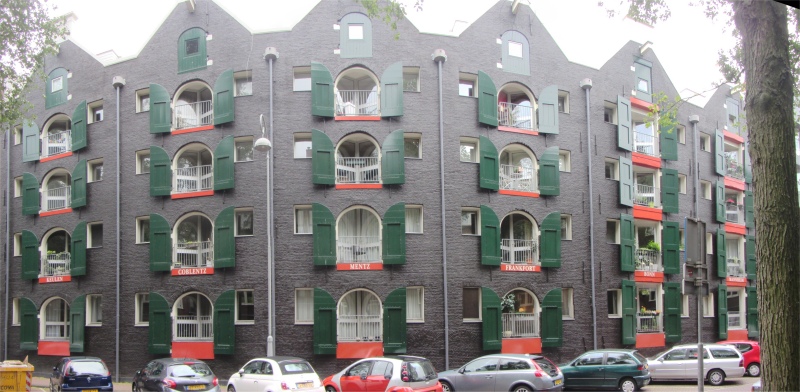
Former Old Warehouses: Keulen, Coblentz, Mentz, Frankfort, Bonn & Mannheim, Now All Flats
|
We reached a natural point where a break was essential, we were getting "museumed out", having spent over four hours traipsing around two of them. Meryl wanted to return back to the boat, so she and Rex returned, while I went walkabout. I picked a canal at random and followed it away from the city centre, just to get a feel for De Gouden Bocht (The Golden Bend), where merchants and residents may have lived at one time.
Without looking at the map, I weaved my way along a maze of canals and streets, roughly following my instinct of direction. It was delightful discovering little visited back streets, taking photos of things that amused or interested me. I lost track of time, but eventually found myself outside the Rembrandt House Museum, opposite which I indulged in a coffee and a spot of people watching while I wrote the words you are now reading.
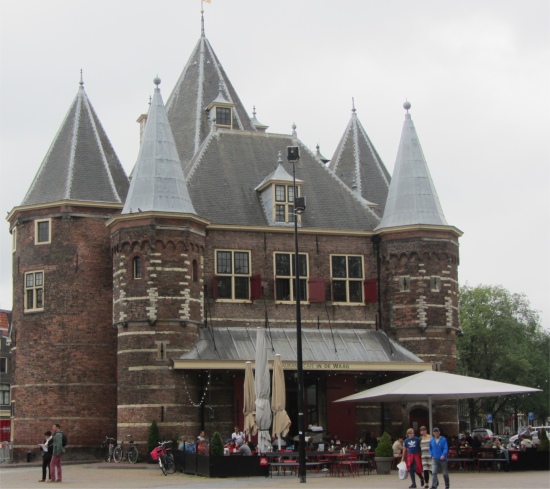
Waag
|

Montelbaanstoren
|
Time was moving on, so I headed back to the Central Station and caught a ferry back across the canal. A very loud ship's horn betrayed the departure of the cruise ship. I had timed it nicely, when I arrived back at the marina the hooting cruise ship was just passing at a leisurely pace. It resembled an enormous block of flats, with numerous figures perched on the top deck, only one of them waving back to the frantically waving kids on a boat just in front of me.
Costa Fortuna was its name, and I bet it did too. Barges and other water traffic kept a respectable distance away from the giant. It slowly slipped away down the canal, heading for the North Sea and an unknown destination.
In the evening we caught a ferry to Westerdok, and walked down alongside a large basin that was lined with small barges, all of them houseboats. They looked well lived in, and some had gorgeous small gardens on them and the pontoons to which they were attached. On the opposite side of the road we were strolling down, modern flats, several storeys high, lined the full length of the Westerdok. What a lovely vantage point. We did not intend to venture too far into the city, and fortunately as we walked down Haarlemmerstraat we stumbled across the Dulac restaurant in which we took refuge from the worsening elements outside. The best way to describe the place is Bohemian, with an eclectic mix of art deco furnishings. Above the bar area a large horizontal millstone structure was suspended, and sticking out horizontally from its circumference was a multitude of small towers and spires. I presumed these were replications of the various church spires found throughout the city. An old juke box stood in a corner, and a D.J.'s desk was set up next to it, by the toilet. Tables and chairs stood on an assortment of floor elevations. A grand mix of background music drifted around the restaurant, a burst of Motown setting our feet tapping. The food was excellent and reasonably priced too.
Now a couple of close friends that Rex and Meryl knew from Tollesbury, Richard and Angela, were coming across to Amsterdam for a long weekend. The plan was to meet up with them on Friday evening for a meal in Amsterdam. Rex and Richard had been communicating via email, text and telepathy regarding a suitable restaurant. It occurred to us that this restaurant would be ideal. So, after we checked that the D.J. would not be in full swing on Friday evening, we reserved a table.
Returning back to the marina, the ferry was still crowded despite the late hour. Does this city ever sleep?

















